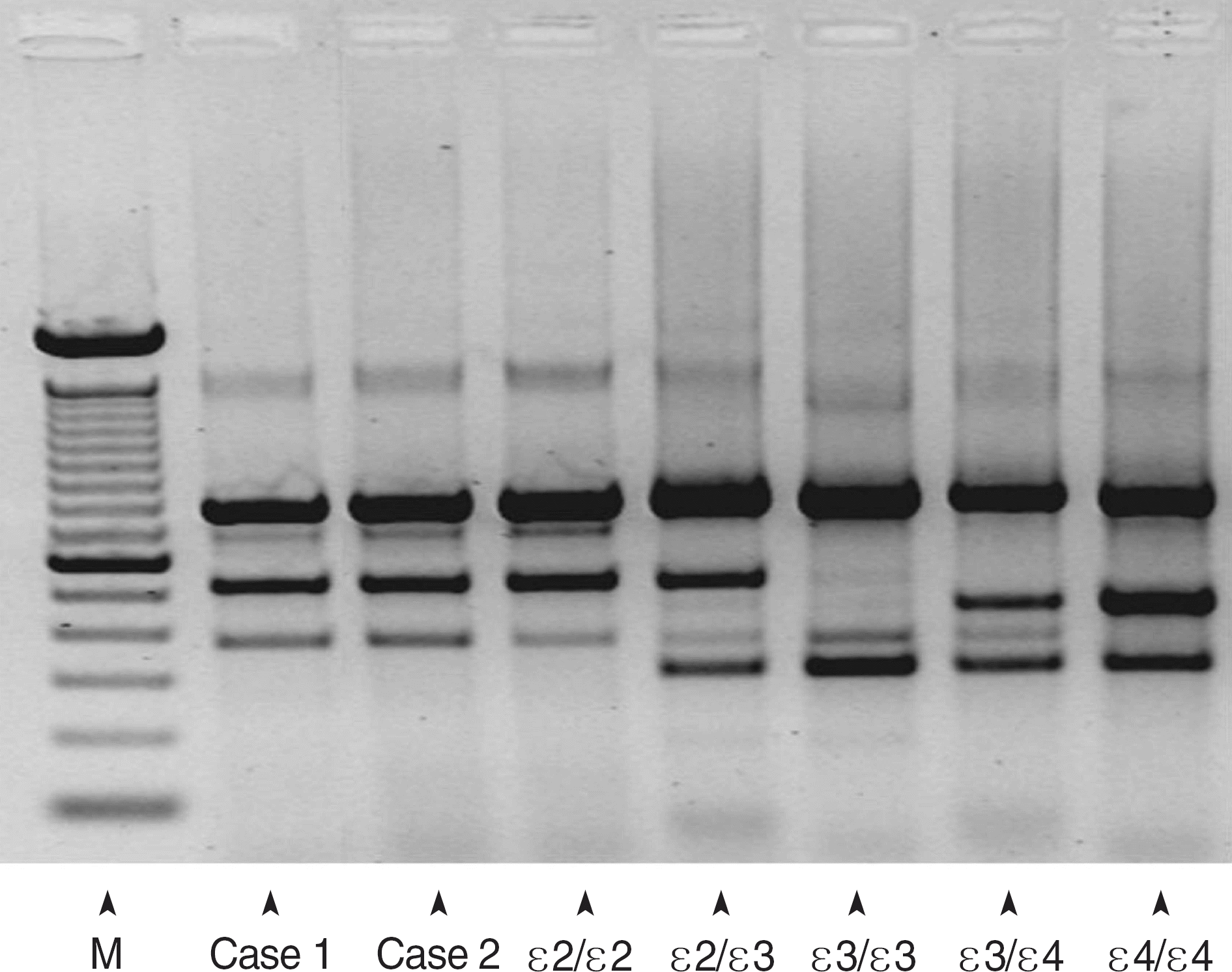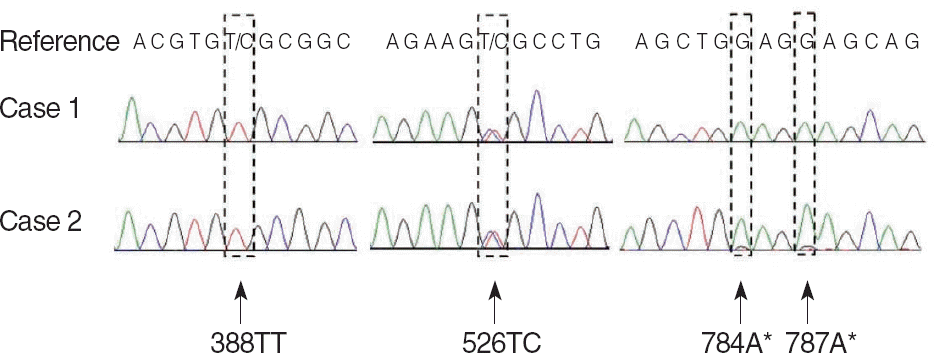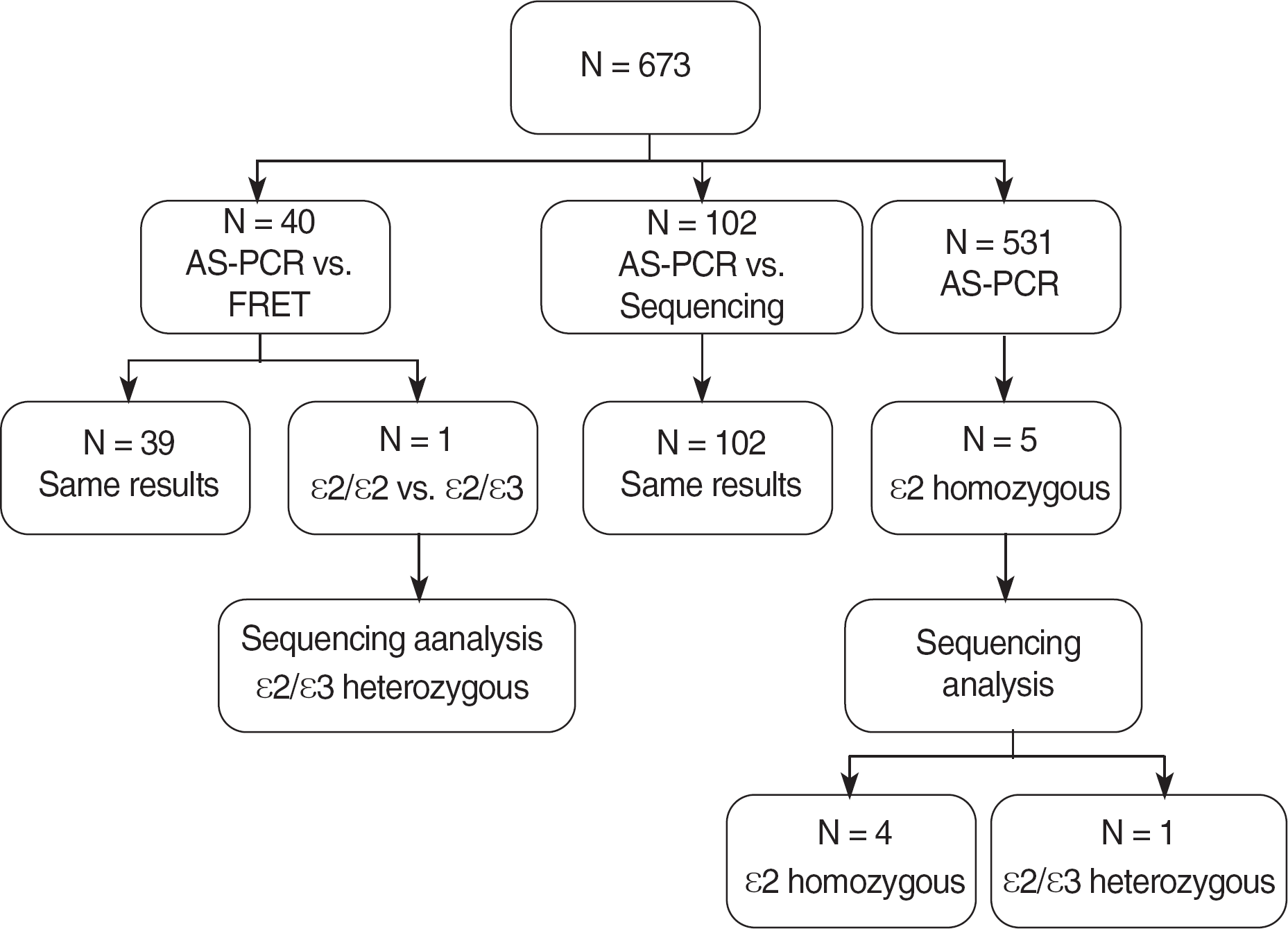Abstract
The human apolipoprotein E (APOE) gene contains several single-nucleotide polymorphisms (SNPs) that are distributed across the gene. The genotype of the APOE gene has important implications as a risk factor for various diseases. We observed 2 cases in which the results of allele-specific PCR (AS-PCR) of the APOE gene were not consistent with those of fluorescence resonance energy transfer (FRET) or sequencing analysis. In these cases, genotyping by AS-PCR showed that patients were ε2 homozygotes, while sequencing analysis and FRET showed that they were ε2/ε3 heterozygotes. Herein, we describe the causes of the errors in genotyping and describe the significance of these errors.
REFERENCES
1.Nickerson DA., Taylor SL., Fullerton SM., Weiss KM., Clark AG., Stengard JH, et al. Sequence diversity and large-scale typing of SNPs in the human apolipoprotein E gene. Genome Res. 2000. 10:1532–45.

2.Corder EH., Saunders AM., Strittmatter WJ., Schmechel DE., Gaskell PC., Small GW, et al. Gene dose of apolipoprotein E type 4 allele and the risk of Alzheimer's disease in late onset families. Science. 1993. 261:921–3.

3.Utermann G., Hees M., Steinmetz A. Polymorphism of apolipoprotein E and occurrence of dysbetalipoproteinaemia in man. Nature. 1977. 269:604–7.

4.Gomez-Isla T., West HL., Rebeck GW., Harr SD., Growdon JH., Locascio JJ, et al. Clinical and pathological correlates of apolipoprotein E epsilon 4 in Alzheimer's disease. Ann Neurol. 1996. 39:62–70.
5.Roses AD. Apolipoprotein E alleles as risk factors in Alzheimer's disease. Annu Rev Med. 1996. 47:387–400.
6.Strittmatter WJ., Saunders AM., Schmechel D., Pericak-Vance M., Enghild J., Salvesen GS, et al. Apolipoprotein E: high-avidity binding to beta-amyloid and increased frequency of type 4 allele in lateonset familial Alzheimer disease. Proc Natl Acad Sci U S A. 1993. 90:1977–81.

7.Kim DS., Lee HS., Choi SI., Suh SP. Modified and improved ARMS PCR method for apolipoprotein E genotyping. Korean J Clin Pathol. 2000. 20:150–6.
8.Donohoe GG., Salomaki A., Lehtimaki T., Pulkki K., Kairisto V. Rapid identification of apolipoprotein E genotypes by multiplex amplification refractory mutation system PCR and capillary gel electrophoresis. Clin Chem. 1999. 45:143–6.

9.Ballerini S., Bellincampi L., Bernardini S., Casciani S., Motti C., Cortese C, et al. Apolipoprotein E genotyping: a comparative study between restriction endonuclease mapping and allelic discrimination with the LightCycler. Clin Chim Acta. 2002. 317:71–6.

10.Nauck M., Hoffmann MM., Wieland H., Marz W. Evaluation of the apo E genotyping kit on the LightCycler. Clin Chem. 2000. 46:722–4.

11.Tajima S., Yamamura T., Menju M., Yamamoto A. Analysis of apolipoprotein E7 (apolipoprotein E-Suita) gene from a patient with hyperlipoproteinemia. J Biochem. 1989. 105:249–53.
12.Yamamura T., Dong LM., Yamamoto A. Characterization of apolipoprotein E7 (Glu(244) → Lys, Glu(245) → Lys), a mutant apolipoprotein E associated with hyperlipidemia and atherosclerosis. J Lipid Res. 1999. 40:253–9.
13.Dong J., Balestra ME., Newhouse YM., Weisgraber KH. Human apolipoprotein E7:lysine mutations in the carboxy-terminal domain are directly responsible for preferential binding to very low density lipoproteins. J Lipid Res. 2000. 41:1783–9.
Fig. 2.
Agarose gel electrophoresis of AS-PCR products. Case 1 and case 2 were ε2/ε2 homozygous. Abbreviation: M, APOE marker.

Fig. 3.
Detection of mutations in the APOE gene by PCR-direct sequencing analyses. Case 1 and case 2 showed 388TT (left), 526TC (middle), and 2 point hemizygous mutations (784A∗ and 787A∗) (right).

Fig. 4.
PCR bands of each allele (ε2, ε3, ε4, and ε7) and their interpretations in AS-PCR. The ε7 alleles of genotypes ε3/ε7 and ε4/ε7 were interpreted as ε3, and the ε7 allele of genotype ε2/ε7 was interpreted as ε2 (dotted box).





 PDF
PDF ePub
ePub Citation
Citation Print
Print



 XML Download
XML Download